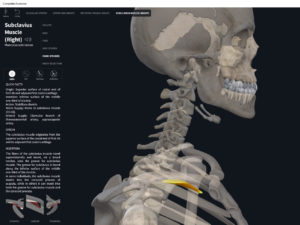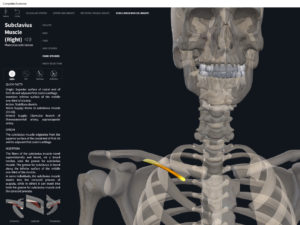Anatomy & Physiology: Muscles—Subclavius.
Structure.
- Origin: first rib.
- Insertion: clavicle.
Function.
- Concentric action: depress and move clavicle anteriorly at sternoclavicular joint (SC); protraction of clavicle at SC, downward rotation of clavicle at SC joint; helps stabilize pectoral girdle.
- Reverse mover action: elevate first rib of sternocostal and costospinal joints.
- Eccentric action: controls/restrains/slows clavicular retraction, elevation, upward rotation, and controls/restrains/slows depression of first rib.
- Isometric action: stabilization of the scapula. Stabilization of clavicle and first rib.
- Innervation: subclavian nerve.
- Arterial supply: clavicular branch of thoracoacromial trunk (branch of axillary artery), suprascapular artery (branch of thyrocervical trunk).
Clinical Significance.
References
Biel, A. (2015). Trail guide to the body: A hands-on guide to locating muscles, bones and more.
Cedars-Sinai. (2018). Vertebrae of the spine. Retrieved from https://www.cedars-sinai.org/health-library/diseases-and-conditions/v/vertebrae-of-the-spine.html
Clark, M., Lucett, S., Sutton, B. G., & National Academy of Sports Medicine. (2014). NASM essentials of corrective exercise training. Burlington, MA: Jones & Bartlett Learning.
Jenkins, G., & Tortora, G. J. (2012). Anatomy and Physiology: From Science to Life, 3rd Edition International Stu. John Wiley & Sons.
Muscolino, J. E. (2017). The muscular system manual: The skeletal muscles of the human body.


